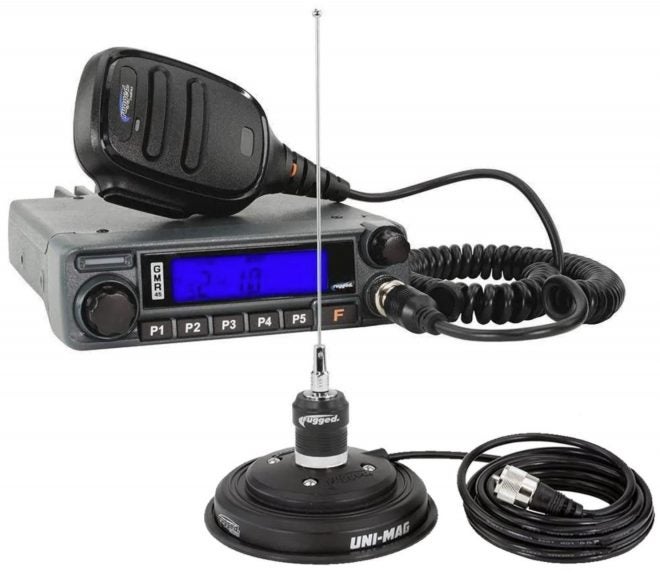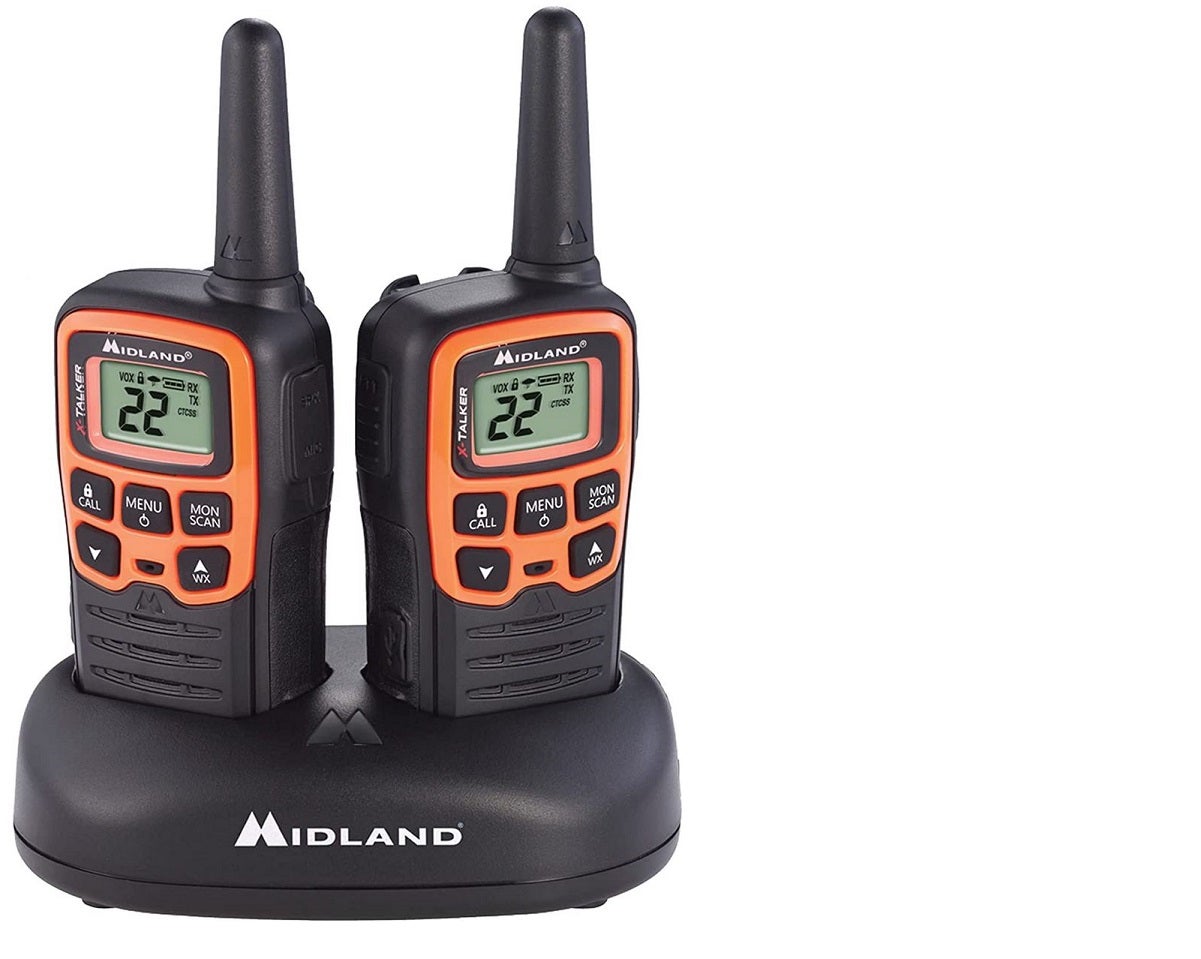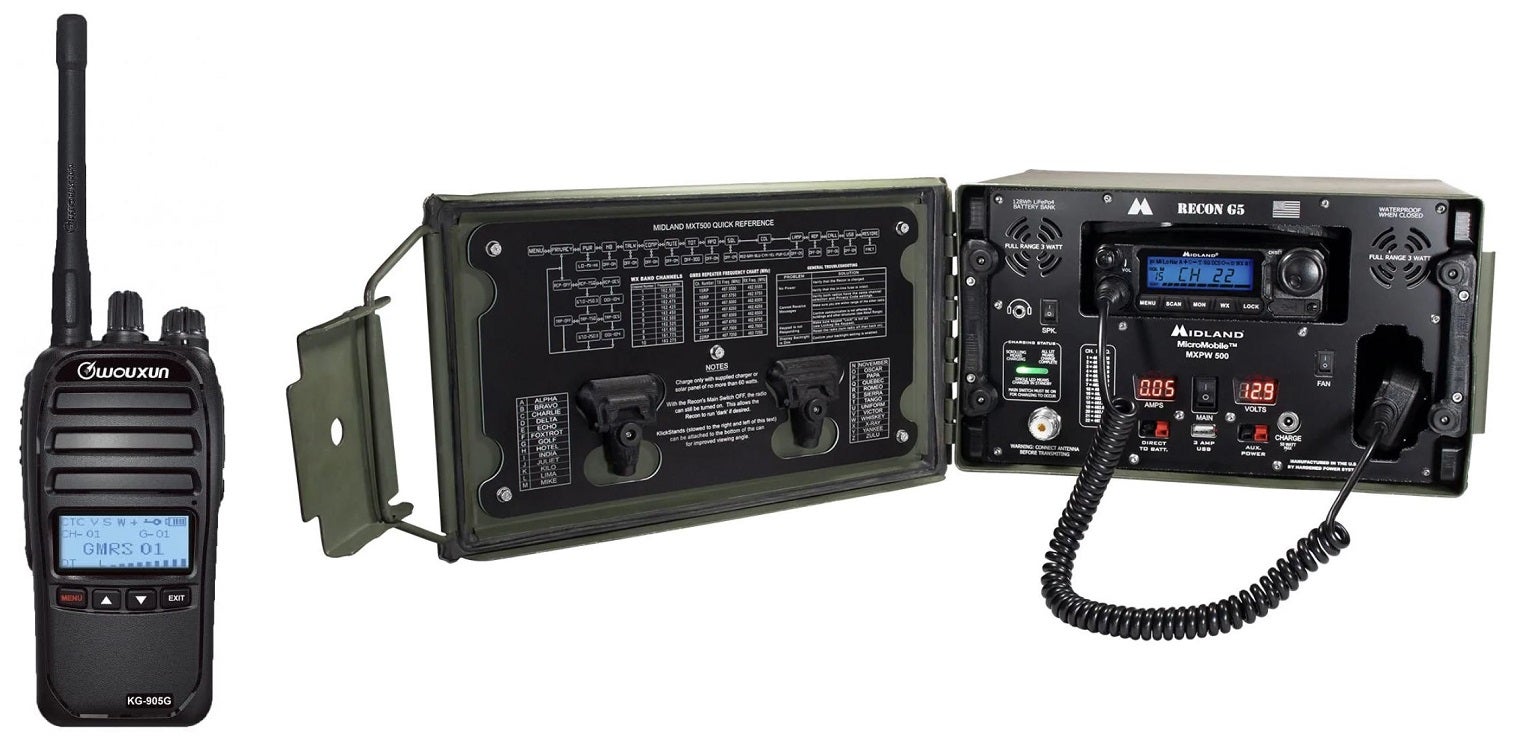Family Radio Service (FRS) vs General Mobile Radio Service (GMRS)
Travis Olander 01.27.23

We previously covered the Ham Radio in a multi-part series. After all, Ham (or “amateur” radio) is the prepper’s number one comms companion, but broadcasting on a Ham radio without running afoul of the law means getting licensed. And that means passing some tests conducted by the FCC. Ham is heavily regulated, and these hurdles can turn off folks, but Ham Radio isn’t the only option available for those who want to invest in emergency communications. Two other radio protocols – Family Radio Service (FRS) and General Mobile Radio Service (GMRS) – provide similar performance, but they’re easier and more affordable to get into. Plus, you don’t need to study to pass one of the FCC’s radio licensing tests. Let’s take a look at these two alternatives to amateur radio.
Family Radio Service (FRS)
The Family Radio Service was made for simple two-way consumer radios. That means Walkie-Talkies and other budget handhelds that were made famous in Radio Shack’s Hayday. FRS radios were first introduced in the 1940s and mostly operated on VHF bands in the 20 to 30 MHz frequencies.
But as CB radio (which also use those frequencies) became popular in the 70s and 80s, the FCC was forced to move FRS frequencies up to 49 MHz. That worked well enough for awhile, until wireless consumer devices (like baby monitors) began interfering. In a final act of deconfliction, the FCC defined frequencies ranging between 462 MHz and 467 MHz (UHF) as dedicated FRS frequencies. FRS radios have stuck to this range of frequencies ever since.
But even still, plenty of other radios and wireless devices operate using the UHF band, including amateur radio. So, to ensure FRS units don’t interfere with other radio equipment, they’re regulated by the FCC and must meet certain physical criteria under a set of regulations called Part 95.
Maximum Allowed Power
FRS radios are limited to an operating power of just 2 watts on channels 15 through 22, and just 0.5 watts on channels 8 through 14.
Narrowband Only
FRS radios must be designed so that peak frequency bandwidth doesn’t exceed 12.5 KHz. This is officially called Narrowband. Wideband allows for a bandwidth of up to 25 KHz, but this increases the risk of interfering with other frequencies and channels.
Fixed Antenna
All FRS radios must have a non-removable antenna. This ensures the end user doesn’t swap out the unit for something that provides higher gain, functioning as a workaround to achieving more power — and thus, potentially introducing more interference.
Family Radio Service (FRS) Channels, Frequencies (MHz) & Power
All FRS radios are preprogrammed to function only on the designated FRS channels and the frequencies assigned to each one. They include:
- Channel 1: 462.5625 (2W)
- Channel 2: 462.5875 (2W)
- Channel 3: 462.6125 (2W)
- Channel 4: 462.6375 (2W)
- Channel 5: 462.6625 (2W)
- Channel 6: 462.6875 (2W)
- Channel 7: 462.7125 (2W)
- Channel 8: 467.5625 (0.5W)
- Channel 9: 467.5875 (0.5W)
- Channel 10: 467.6125 (0.5W)
- Channel 11: 467.6375 (0.5W)
- Channel 12: 467.6625 (0.5W)
- Channel 13: 467.6875 (0.5W)
- Channel 14: 467.7125 (0.5W)
- Channel 15: 462.5500 (2W)
- Channel 16: 462.5750 (2W)
- Channel 17: 462.6000 (2W)
- Channel 18: 462.6250 (2W)
- Channel 19: 462.6500 (2W)
- Channel 20: 462.6750 (2W)
- Channel 21: 462.7000 (2W)
- Channel 22: 462.7250 (2W)
FRS Does Not Require FFC Licensing
Since FRS radios are heavily regulated, relatively low power, and preprogrammed without the ability to be modified, one does not need to obtain any particular FCC broadcast license to use one.
FRS Radios Are Only Good for Short Distances
When we say “short distances,” we mean under two miles. Sure, you may see certain FRS radios (like these Midland X-Talkers) advertise maximum distances of up to 28 miles! Except the big disclaimer is that obtaining that kind of range means you’re standing in a perfectly open, flat desert landscape with no other wireless transmissions. In real-world conditions, such as in your local suburb, you can expect about a mile of good range. In cities, it’s even less.
General Mobile Radio Service (GMRS)
The General Mobile Radio Service is similar to FRS: It’s designed to function in the UHF range of 462 to 467 MHz, and the radio protocol itself is largely made for private individuals and civilian use. GMRS radios must also be certified under Part 95, and the two radio protocols even share certain channels.
But comparing FRS to GMRS is like comparing a Honda Civic to a track car: GMRS massively outperforms FRS, with operating power outputs up to 50 watts, or 100 times more than FRS handhelds. In addition to functioning on the same 22 channels available to FRS, GMRS makes use of 8 additional channels, reserved only for GMRS.
General Mobile Radio Service (GMRS) Channels, Frequencies (MHz) & Power
- Channel 1: 462.5625 (5W)
- Channel 2: 462.5875 (5W)
- Channel 3: 462.6125 (5W)
- Channel 4: 462.6375 (5W)
- Channel 5: 462.6625 (5W)
- Channel 6: 462.6875 (5W)
- Channel 7: 462.7125 (5W)
- Channel 8: 467.5625 (0.5W)
- Channel 9: 467.5875 (0.5W)
- Channel 10: 467.6125 (0.5W)
- Channel 11: 467.6375 (0.5W)
- Channel 12: 467.6625 (0.5W)
- Channel 13: 467.6875 (0.5W)
- Channel 14: 467.7125 (0.5W)
- Channel 15: 462.5500 (50W)
- Channel 16: 462.5750 (50W)
- Channel 17: 462.6000 (50W)
- Channel 18: 462.6250 (50W)
- Channel 19: 462.6500 (50W)
- Channel 20: 462.6750 (50W)
- Channel 21: 462.7000 (50W)
- Channel 22: 462.7250 (50W)
- Channel 15R: 467.5500 (50W)
- Channel 16R: 467.5750 (50W)
- Channel 17R: 467.6000 (50W)
- Channel 18R: 467.6250 (50W)
- Channel 19R: 467.6500 (50W)
- Channel 20R: 467.6750 (50W)
- Channel 21R: 467.7000 (50W)
Channel 22R: 467.7250 (50W)
GMRS Radios Can Reach Hundreds of Miles
In addition to their higher power output (and subsequently increased range) GMRS radios can make use of repeaters. This is a critically important distinction against FRS. Repeaters allow even a simple handheld unit operating on just 5 watts to increase its range from a few miles to a few hundred miles.
Using GMRS Requires FCC Licensing
The fee for acquiring a GMRS license varies, but a single operator’s license for one radio costs just $35. And, unlike Ham Radio licenses, you don’t need to take a complicated exam and your license is also good for immediate family members. The GMRS license is good for a decade, so you don’t need to shell out cash to the FCC every year just to broadcast.
Obtaining the GMRS License
Thankfully, everything can be done online. You’ll need to register on the FCC’s “Commission Registration System” (CORES) here. Once you’ve registered, log into the FCC’s License Manager using your new FCC Registration Number and password. In the Manager, click on “Apply for a New License.” Then select “Radio Service” from the dropdown menu. Continue through the application, filling out the necessary information, then submit the application.
You’ll receive an invitation to pay the $35 fee separately, after the application has been submitted. You can check the status of your application using the FCC’s Application Search. It can take up to two business days for your application to process and be approved. Once your application’s approved, you’ll need to log back into the License Manager and click on “Download Electronic Authorizations.” There, you’ll see your new GMRS license and callsign. With an approved application, you can begin using your GMRS radio at your leisure.
Which Handheld Radio Is Best for SHTF?
Any radios from Wouxun are going to provide ample capability, including functioning with both FRS and GMRS protocols. The Wouxun KG-905G is a durable handheld unit that outputs at up to 5 watts, and it can function with Private Line communications via CTCSS and DCS. Thanks to waterproofing and a long battery life, this unit’s favored by preppers and off-roaders alike.
If you’re not sure what Private Line comms are, check out our Ham Radio Guide to Advanced Programming. To take full advantage of GMRS’ 50-watt limit, Midland’s MXT575 base station does a great job. If you want to keep things simple and short-range, Midland’s FRS Radios do just fine. They have up to 121 CTCSS codes for private line comms, and they’re preprogrammed with NOAA channels to receive weather reports.

